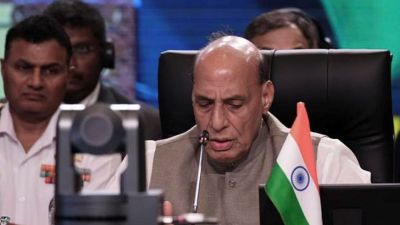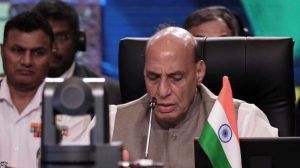Decode Politics: Why Bhojshala row has returned to roil Madhya Pradesh politics again
Right-wing groups claim the Kamal Maula mosque was built on the remains of a Saraswati temple and that the goddess’s idol was taken to London by the British in 1857
 The Bhojshala Saraswati temple and Kamal Maula mosque monument is an ASI protected site in the ancient town of Dhar, Madhya Pradesh. (Photo: Wikimedia Commons)
The Bhojshala Saraswati temple and Kamal Maula mosque monument is an ASI protected site in the ancient town of Dhar, Madhya Pradesh. (Photo: Wikimedia Commons)The Madhya Pradesh High Court has ordered the Archeological Survey of India (ASI) to conduct a survey of the Bhojshala temple-cum-Kamal Maula mosque complex in Dhar district, observing that its nature and character need to be “demystified and freed from the shackles of confusion”.
Since the early 2000s various right wing groups in the state have been seeking the closure of the mosque, a ban on Friday namaz in it and the installation of a Saraswati idol in the Bhojshala complex.
In April 2003, the ASI had made an arrangement to find a solution under which Hindus would perform puja in the premises on Tuesdays while Muslims would offer namaz there on Fridays.
On May 2, 2022, a PIL was filed by the Hindu Front for Justice challenging the ASI order which restricted daily worship at the Bhojshala for Hindus. The plea cited that the former rulers of Dhar had installed the statue of Saraswati there in 1034 AD and it was taken to London in 1857 by the British.
Origin of dispute at the site
At the centre of Dhar city, over 250 kms away from Bhopal, is the tomb of Kamal al-Din, a Chishti saint and follower of Farid-al Din Ganj-i-Shakar and Nizam al-Din Auliya.
 The “liberation” of Bhojshala was one of the major issues in the run-up to the 2003 Assembly elections which saw the ouster of the Digvijaya Singh-led Congress government. (Photo: Wikimedia Commons)
The “liberation” of Bhojshala was one of the major issues in the run-up to the 2003 Assembly elections which saw the ouster of the Digvijaya Singh-led Congress government. (Photo: Wikimedia Commons)
His tomb was built adjacent to a spacious hypostyle mosque “built primarily of reused temple parts”. This led to demands by the right wing groups that the complex is a temple dedicated to the Goddess Vagdevi (Saraswati). The Hindu Front for Justice argued that the mosque was constructed during the reign of Alauddin Khilji between the 13th and 14th centuries after “destroying and dismantling ancient structures of previously constructed Hindu temples”.
According to a 2012 research paper by Micheal Willis published in the Royal Asiatic Society, the Bhojshala or ‘Hall of Bhoja’ is a term used to describe the centre for Sanskrit studies associated with King Bhoja, the most celebrated ruler of the Paramara dynasty.
“Since the early years of the twentieth century, the mosque adjacent to the tomb of Kamal al-Dın Chisti in Dhar has been identified as the Bhojshala which has “turned the building into a focal point of religious, social and political tension,” he noted
According to the Dhar district website, Raja Bhoj founded a college at Dhar, which subsequently came to be known as Bhojshala.
In his paper titled “Dhar, Bhoja and Sarasvati: from Indology to Political Mythology and Back”, Willis noted, “A variety of pillars used in the building, and the number of inscribed tablets still visible in the floor with yet others displayed along the walls, show that the materials for this building were collected from a number of old sites over a wide area.”
Willis also noted that the construction of the mosque copied the Qutb (Minar) in Delhi and that the buildings did not use temple material because nothing else was available or temple pillars were a “triumphant display of Islamic supremacy”. “Rather, the reuse of old temple parts represented a comprehensive appropriation of the resources of the past – both architectural and cultural – and their radical reconfiguration into a new kind of sacred space unknown in India before the appearance of Islam,” he wrote.
How did Bhojshala gain traction?
The mosque has been referred to in the writings of English author John Malcolm in 1822 and William Kincaid in 1844. While they documented popular legends associated with Raja Bhoj, they never identified the Bhojshala.
Willis pointed out that Alois Anton Fuhrer, a German Indologist, who worked for the ASI, travelled to Central India in 1893 and recorded the mosque complex with the term “Bhoja’s school”. However, Fuhrer was dismissed from his position in the ASI after an investigation uncovered an enormous degree of bad scholarship.
In 1902, a small archeological department office was established in Dhar by the British government and Superintendent of State Education, K K Lele was made its in-charge. At the time the British were investing in research to modernise the Indian government and Lele in his enquiry found “two serpentine inscriptions giving the alphabet and grammatical rules of the Sanskrit language.”
“The basic conundrum for Lele was that if the mosque at Kamal al-Din was going to be explained away as a reused Hindu building, then some sort of Sanskrit basis had to be found for ‘Bhoja’s school’, the designation ‘Raja Bhoja ka Madrassa’ being too manifestly Urdu to serve his purpose,” he added.
Willis argued that Lele addressed this problem by inventing the term Bhojshala as the Sanskrit language would refer to educational institutions with “vidyalaya”, “vidyapeeth” or “jnanpith”. “Lele coined the term to provide the descriptive terminology he needed for the pillared colonnades of the mosque and so advance the idea that the building was indeed an old structure put to new use by the Muslims,” he wrote.
Theories surrounding the idol
Art historian O C Ganguly and then Director-General of the ASI discovered an “inscribed sculpture” in the British Museum and announced that it was “Bhoja’s Saraswati from Dhar”. Over time, many others would back this claim.
However, Willis has argued against Ganguly’s theory. “Already in 1943, Lele, who had access to the archival sources, reported that the sculpture had been found in the debris of the old city palace in 1875…The current location of Saraswati from Dhar remains an interesting mystery seeing that it is not located in the British Museum,” he wrote.
How did the row flare up?
The “liberation” of Bhojshala was one of the major issues in the run-up to the 2003 Assembly elections which saw the ouster of the Digvijaya Singh-led Congress government. The BJP had also accused the Digvijaya government of “creating a communal problem”.
Multiple attempts have been made by the right-wing groups to enter the complex and hoist a saffron flag there. The local police have also imposed curfew several times, most notably in 1997 after the Vishwa Hindu Parishad (VHP) threatened to hoist a flag atop the ancient structure leading to the arrest of 40 people.
In 2003, former CM Shivraj Singh Chouhan, who was then the BJP MP from Vidisha, informed the Lok Sabha that “the State government had banned the entry of Hindus in Bhojshala while suppressing their feelings”.
The Chouhan-led BJP government in 2022 promised to bring back the Saraswati idol from the British Museum.





- 01
- 02
- 03
- 04
- 05


























